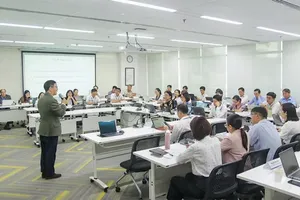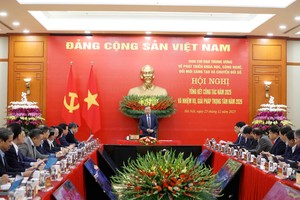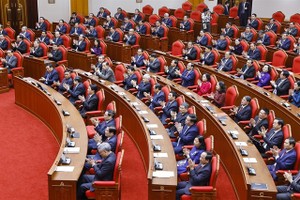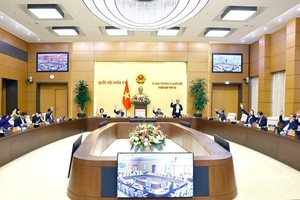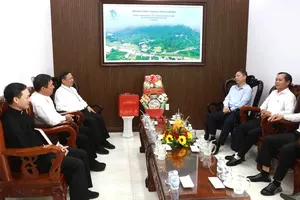These challenges have hindered investment attraction and slowed down the region's development process in recent years.

Low local training quality
Long An Province currently hosts 34 industrial parks, with plans to increase this figure to 51 by 2030. This expansion will necessitate the recruitment of tens of thousands of skilled workers. However, according to Ms. Nguyen Hong Mai, Director of Long An Province's Department of Labor, Invalids, and Social Affairs, local efforts to train these skilled workers have yet to meet the requirements of investors and employers, even in the near future.
The province currently boasts only 14 vocational education institutions, including four colleges, with an inadequate number of qualified teachers. Furthermore, aside from the shortage of teaching staff, the training facilities for skilled laborers are also insufficient, particularly in emerging fields such as semiconductor technology and information technology.
The majority of the local workforce supplied to industrial parks, transitioning from agriculture, has not yet met the skill, discipline, and work habit requirements of the industrialization and modernization period. According to the leadership of Long An Province's Department of Labor, Invalids, and Social Affairs, to proactively attract foreign investors and implement the province's directives, they have been working with the Department of Education and Training for nearly two years to develop a training project for the semiconductor industry.
However, this project has remained on paper until now. Many departments are struggling and facing difficulties in organizing training due to the rapid development of the semiconductor field. Without timely updates to meet investor needs and conditions, training programs will quickly become outdated. Moreover, there are currently very few semiconductor training facilities in Long An Province.
In Hau Giang Province, the training and policy mechanisms for attracting skilled labor are facing similar challenges. Mr. Truong Canh Tuyen, Standing Vice Chairman of the People's Committee of Hau Giang Province, noted that public sector policies and salaries are lower than those in the private sector, failing to meet the living needs of officials, civil servants, and public employees. This lack of competitive compensation has not created the motivation or attractiveness needed to draw skilled labor to work in the province.
Some local authorities and units have not adequately prioritized the development and improvement of human resources. As a result, the leadership and execution of training and retraining plans for officials, civil servants, and public employees have been ineffective, leading to a shortage of skilled labor. Additionally, many officials, civil servants, and public employees sent for postgraduate training do not return to work in the province after completing their education.
Additionally, infrastructure, living conditions, and work environments in some provinces are still limited, with few high-quality enterprises investing in the area. In terms of training, there are very few large-scale, high-quality training institutions, limiting the ability to meet business needs. Some training institutions have low student enrollment, and the streamlining of high school graduates into vocational training has not met expectations. Consequently, the skilled labor force in Hau Giang Province, especially in the four priority development areas, namely industry, agriculture, urban development, and tourism, does not meet the overall development needs of the province.
Unattractive work environment
The work environment is considered a crucial factor in attracting skilled labor. Attractive work environments make it easier to draw in talent. However, many localities, units, and enterprises in the Mekong Delta have not excelled in this area. Pham Ngoc Nhan, currently working at a foreign company in Ho Chi Minh City, shared his experience. Despite having a master's degree and previously working as a lecturer at a prestigious university in Can Tho City, where his salary and allowances were sufficient to cover living expenses, he decided to leave his teaching job three years ago to work at a company in Ho Chi Minh City.
“At the university, I didn't have many teaching hours. The rest of my time was spent hosting guests or doing paperwork assigned by my superiors. Doing these repetitive tasks caused my knowledge to fade,” Nhan shared. Faced with this situation, he decided to move to a company. Despite receiving a salary comparable to his previous job, working at a company enabled him to make a greater impact, stimulated his intellect, and provided more opportunities to leverage his skills and strengths, leaving him highly satisfied.
Similarly, Thanh, a friend of Nhan, previously worked at a department under the Ca Mau Provincial People's Committee in the field of information technology but later switched to the private sector. In 2013, Thanh was selected to pursue a master's degree under the Mekong 1,000 program (a program sending 1,000 officials from the Mekong Delta for advanced training). At that time, skilled IT professionals were scarce.
"I was thrilled when I was sent to Germany for further education, expecting that upon my return, I would be placed in a position that matched my skills and expertise, offering ample opportunities for career advancement and professional development. However, upon completing my training and returning, I was assigned to various provincial agencies to repair computers. When that task ended, I was reassigned to the Department of Internal Affairs for office work, unrelated to my trained expertise. Disillusioned with the unprofessional work environment, I resigned and moved to Binh Duong to seek more suitable employment," Thanh explained.
Thanh and Nhan are among hundreds of officials and civil servants in the Mekong Delta provinces who have resigned in the past three years due to unattractive work environments. Specifically, in Bac Lieu Province, within the healthcare sector alone, over 100 individuals have left their positions since 2020. Among them, many doctors and pharmacists who, despite their expertise and years of service, have relocated to larger cities seeking opportunities for career advancement and professional development.
Limited budget hinders talent attraction
Mr. Nguyen Phuong Lam, Director of the Vietnam Chamber of Commerce and Industry (VCCI) in Can Tho, pointed out that attracting investment to the Mekong Delta has been notably low over recent decades, both in terms of foreign direct investment (FDI) and domestic private investment. Recent economic reports (Annual Economic Reports for 2020, 2022, and 2023) highlight that the primary cause is inadequate infrastructure to support investment needs.
Consequently, the region faces low investment levels and a less dynamic job market, which hinders its ability to attract skilled labor and resources. Furthermore, the slower pace of urbanization compared to other regions and the lack of high-quality amenities for living and entertainment also contribute to its challenges in attracting professionals, researchers, and individuals with higher qualifications to work and settle in the area.
According to Professor Ha Thanh Toan from Can Tho University, the Mekong Delta covers about 40,000 square kilometers with a population of 18 million people. Previously, it contributed 25 percent to the national GDP, but due to slow progress in recent years, its share has declined to around 18 percent.
The Mekong Delta also lacks attractive policies for sectors like technology and entrepreneurship to draw in startup experts. Mr. Le Van Han, Chairman of Tra Vinh Province's People's Committee, noted that despite a local shortage of skilled labor, the province has been unable to implement resolutions to attract talent due to budget constraints, which stifle demand.
Moreover, the region's limited budget and low compensation have led to a persistent brain drain in Tra Vinh Province. "Many teachers with master's degrees have left their jobs after over a decade of service. It is understandable because, with a monthly salary of VND3-4 million, they struggle to meet living expenses. Conversely, in Ho Chi Minh City or other major urban centers, even as factory workers, they can earn double or triple that amount," said the provincial leader of Tra Vinh.
According to statistics from the Ministry of Education and Training, the higher education system in the Mekong Delta region currently comprises 17 universities, including 11 public and six private. Each year, these universities produce approximately 25,800 undergraduate students and 1,780 master's and doctoral graduates for the labor market. Among them, Can Tho University is the largest contributor, with over 10,000 undergraduate students and over 1,000 master's and doctoral graduates.
Despite a gradual increase in the proportion of trained labor with diplomas and certificates from vocational training upwards in the Mekong Delta (rising from 6.6 percent of the population in 2009 to 9.7 percent in 2019), the growth rate has been sluggish. This rate remains notably lower than the national average of 19.2 percent. On the other hand, the Mekong Delta Region has a rate of 90.3 percent of the population aged 15 and over who have not received any training.
